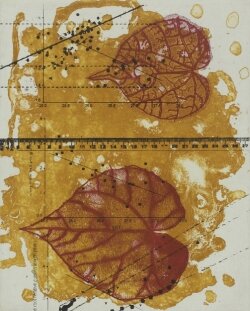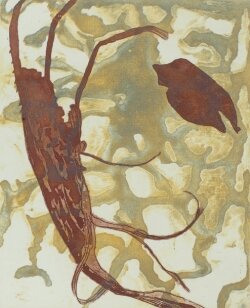Down under water: Watson looks below the surface
Riding shotgun in a tiny plane flying low over Australia's Great Barrier Reef is one my favorite memories. As the pilot took a serpentine course back and forth across the formation— some of its islands rising above the ocean’s surface, some not quite— I was mesmerized by the colors and shapes, which subtly changed with the movement of water and light.
The experience washed over me again as I spent time with Judy Watson’s exhibition of etchings, “heron island suite,” currently on display at the Kluge Ruhe Aboriginal Art Collection. Watson, whose mother is of the Waanyi people of Northwest Queensland, created the prints after serving as artist-in-residence at the University of Queensland’s Heron Island Research Station on the Great Barrier Reef. She set up her studio in a lab and spent her days not only observing and collecting items from around the island— including charred relics from when the original station burned in 2007— but also learning about the research interests of the facility’s scientists.
All of these activities come into play in the resulting etchings, which bring together descriptive illustrations with watery abstract shapes, often overlaid with graphs and scientific charts. Watson uses multiple plates to create each print and varies her palette to reflect the earthiness of the island and the luminosity of the surrounding sea.
Now and then, Watson re-uses a plate, changing the context of its content. For instance, a linear illustration of a clamshell that occurs in “heron island suite #1,” where it floats like an island in a frothy sea of electric blue, reappears in “heron island suite #14,” where Watson shifts the background to coppery sand and overlays the image with a white graph of diagonal lines and white circles.
The charts Watson includes delineate the effects climate change and pollution are having on the Reef, such as mapping endangered sea turtles’ feeding patterns and tracking coral calcification. In her prints, however, the scientific information becomes secondary to the graphs’ aesthetic qualities, particularly in the way their staccato geometry contrasts with organic areas of diffuse and watery ink.
Watson intuitively balances each piece’s components and skillfully manipulates the inks to create a mix of articulation and abstraction, opacity and transparency. Working on micro- and macrocosmic levels, her etchings offer detailed illustrations of collected specimens coexisting with layered colors and shapes that suggest aerial views of an effervescent ocean washing over island reefs.
Judy Watson’s exhibition of etchings, “heron island suite,” is on view through December 18 at the Kluge Ruhe Aboriginal Art Collection. A video documenting Watson’s time at the Heron Island Research Station and providing insight into her creative process accompanies the show. 400 Worrell Dr., 244-0234.


